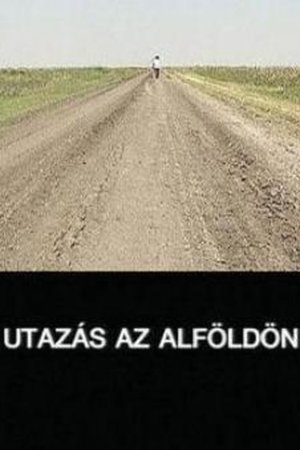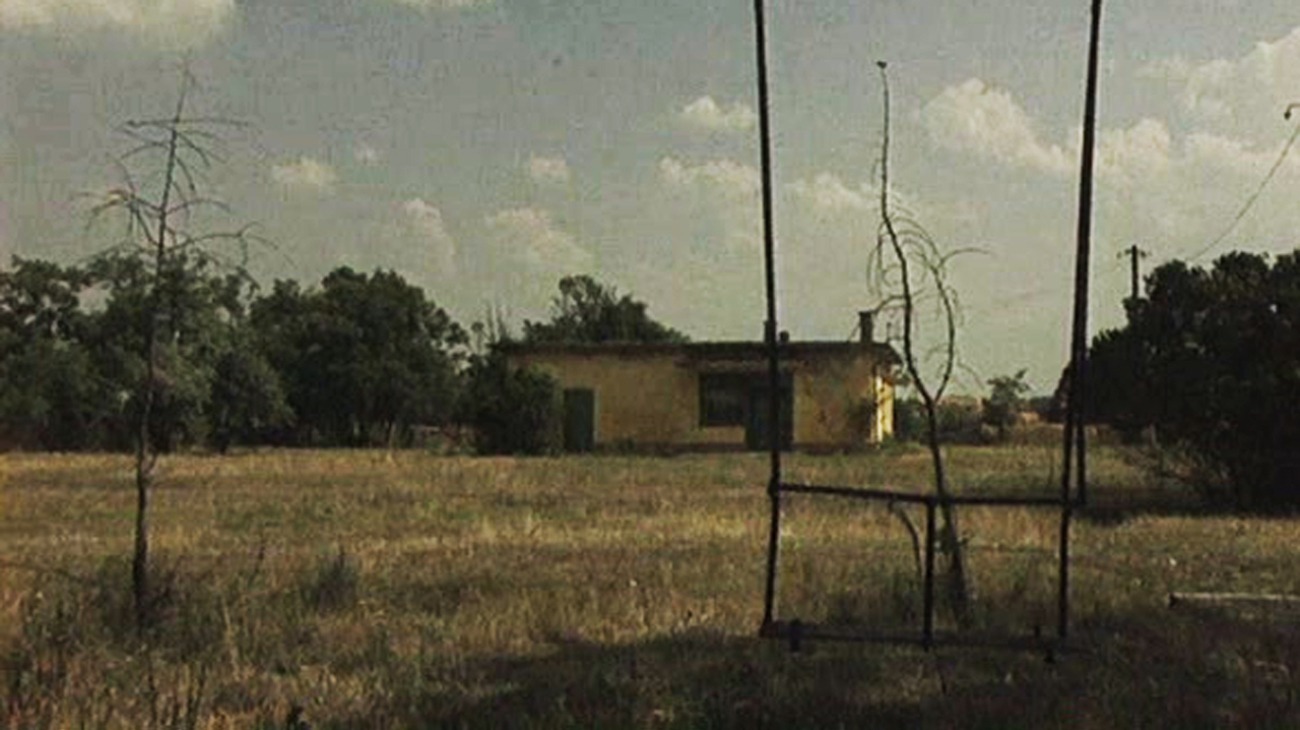
Tarr B_la stays mainly in the plain
At heart, Tarr Béla's curious little noodle of a movie from 1995, the 35-minute Journey on the Plain, is an exercise, not quite avant-garde enough to be a genuine experimental film but totally lacking in narrative or insisted-upon theme. And in this respect, it's the only such film in the director's career, for no matter how much we who love him like to talk him up as a devastatingly complex and unconventional filmmaker, he's still ultimately making stories about characters whose actions suggest meanings. None of that here. What this is, is a film shot on full-color video, with Vig Mihály, the composer and one of the main stars of Tarr's feature from the year prior, Sátántangó, reading pieces from the greatly beloved Hungarian poet-revolutionary Petöfi Sándor, in the same fields and locations where Sátántangó was shot.
Three thoughts present themselves, and in this order:
-Journey on the Plain is less a "movie" and more an attempt to marry subdued, semi-melancholic imagery to the work of Hungary's foremost poet, foregrounding his poetry and serving mostly as a visual and aural backdrop to his words.
-Poetry, more than any other form of art that has yet existed, depends for its greatest impact on being experienced in the language in which it was originally written, so that not merely the meaning but the flow and emphasis of certain words for greater impact can be understood and enjoyed.
-I don't speak a word of Hungarian.
This matters, and it would be silly and disingenuous to pretend that it doesn't. The whole project is an examination of nuances, of what word and what image combine, of what expressions we might read into Vig's face as he recites specific emotions. "Poetry is what gets lost in translation", Robert Frost famously said, and I have only rarely been as keenly aware of that while watching a movie as during Journey on the Plain.
Which isn't the same at all as saying that the film is devoid of value to the non-Magyar viewer. Cinema being a visual language and all, and this clearly subscribing to the particular styles and cinematic techniques of Tarr's mature period. If absolutely nothing else was true of the film, having the chance to compare footage shot on black-and-white film by Medvigy Gábor with footage of the same locations shot on color video by Fred Kelemen (his first of three collaborations with Tarr) is downright revelatory. There's something about black and white that just suits the director's timeless and placeless storytelling better than than color. Seeing, the shot of a man walking for what feels like several minutes down a dirt path towards the camera, to name the most prominent example of something that appears in both films almost exactly the same way, really underlines that: when it's in gritty, jagged video color, it lacks the ethereal, hypnotic quality of Sátántangó itself. And yet, by virtue o that same nasty video, there remains a heightened, distancing quality that keeps us in a different kind of abstracted, removed place from the material. One that perhaps suits it better as a poetry performance piece; certainly, imagining the same material presented in the cosmically gloomy register of the director's features simply doesn't work at all.
The chosen poetry is assembled to suggest a kind of "cycle of life" narrative, broadly sketching out a pattern by which love is found and then lost, and the general progression of shots (unless my memory has gone off on me, each poem is recited in a single long take, though virtually none of those are static; conversely, there are a few long static shots without any words being spoken) moves from empty fields to empty building, representing a kind of building-up over time, though the end point of life represented in the movie is a ragged, abandoned one. That being said, this is surprisingly far from Tarr's usual "we are all in a decaying, lifeless universe" themes, in part because Vig has a certain spry casual body language that never makes it appear like he's truly unhappy, and the music he provides to the film - playing it on-camera in the bed of a moving pick-up truck on one shot - has a certain yearning rather than despondent quality. And the film ends on a surprisingly placid final shot of a child on an ancient-looking swing, one of the few frames in any Tarr movie that could rightfully be called "hopeful"; this last shot is explicitly termed a dedication, giving the impression that we're meant to view it as the hand-off to younger people who might do a better job of living than the grown-ups have.
As tightly yoked as it is to Sátántangó, it's hard not to view it as a deliberate contrast: in length, in color, in simplicity of narrative (the former film a complicated nest of chronology, this film literally devoid of any plot to keep track of), and in emoitional tenor. Undoubtedly, the long-in-planning creation of that film required a bit of a respite, and Journey on the Plain does undoubtedly feel like a minor work, nor is it solely because of the comparison. That said, simplicity is no vice, and the straightforward presentation of feelings in a concise and direct package, but with the same vocabulary as Tarr's messier and more daunting films is undoubtedly bracing. In its own little way, just for supplying a vigorous contrast, it is essential for understanding how the man's cinema works; and while some of the shots are a bit over-conceived to no end (the camera pointing up through a chimney or some other sort of brick channel, rotating in a circle, is distracting and frankly silly), the thing as a whole has its own kind of low-fi beauty. It's an odd little B-side, but rewarding in its own right.
Three thoughts present themselves, and in this order:
-Journey on the Plain is less a "movie" and more an attempt to marry subdued, semi-melancholic imagery to the work of Hungary's foremost poet, foregrounding his poetry and serving mostly as a visual and aural backdrop to his words.
-Poetry, more than any other form of art that has yet existed, depends for its greatest impact on being experienced in the language in which it was originally written, so that not merely the meaning but the flow and emphasis of certain words for greater impact can be understood and enjoyed.
-I don't speak a word of Hungarian.
This matters, and it would be silly and disingenuous to pretend that it doesn't. The whole project is an examination of nuances, of what word and what image combine, of what expressions we might read into Vig's face as he recites specific emotions. "Poetry is what gets lost in translation", Robert Frost famously said, and I have only rarely been as keenly aware of that while watching a movie as during Journey on the Plain.
Which isn't the same at all as saying that the film is devoid of value to the non-Magyar viewer. Cinema being a visual language and all, and this clearly subscribing to the particular styles and cinematic techniques of Tarr's mature period. If absolutely nothing else was true of the film, having the chance to compare footage shot on black-and-white film by Medvigy Gábor with footage of the same locations shot on color video by Fred Kelemen (his first of three collaborations with Tarr) is downright revelatory. There's something about black and white that just suits the director's timeless and placeless storytelling better than than color. Seeing, the shot of a man walking for what feels like several minutes down a dirt path towards the camera, to name the most prominent example of something that appears in both films almost exactly the same way, really underlines that: when it's in gritty, jagged video color, it lacks the ethereal, hypnotic quality of Sátántangó itself. And yet, by virtue o that same nasty video, there remains a heightened, distancing quality that keeps us in a different kind of abstracted, removed place from the material. One that perhaps suits it better as a poetry performance piece; certainly, imagining the same material presented in the cosmically gloomy register of the director's features simply doesn't work at all.
The chosen poetry is assembled to suggest a kind of "cycle of life" narrative, broadly sketching out a pattern by which love is found and then lost, and the general progression of shots (unless my memory has gone off on me, each poem is recited in a single long take, though virtually none of those are static; conversely, there are a few long static shots without any words being spoken) moves from empty fields to empty building, representing a kind of building-up over time, though the end point of life represented in the movie is a ragged, abandoned one. That being said, this is surprisingly far from Tarr's usual "we are all in a decaying, lifeless universe" themes, in part because Vig has a certain spry casual body language that never makes it appear like he's truly unhappy, and the music he provides to the film - playing it on-camera in the bed of a moving pick-up truck on one shot - has a certain yearning rather than despondent quality. And the film ends on a surprisingly placid final shot of a child on an ancient-looking swing, one of the few frames in any Tarr movie that could rightfully be called "hopeful"; this last shot is explicitly termed a dedication, giving the impression that we're meant to view it as the hand-off to younger people who might do a better job of living than the grown-ups have.
As tightly yoked as it is to Sátántangó, it's hard not to view it as a deliberate contrast: in length, in color, in simplicity of narrative (the former film a complicated nest of chronology, this film literally devoid of any plot to keep track of), and in emoitional tenor. Undoubtedly, the long-in-planning creation of that film required a bit of a respite, and Journey on the Plain does undoubtedly feel like a minor work, nor is it solely because of the comparison. That said, simplicity is no vice, and the straightforward presentation of feelings in a concise and direct package, but with the same vocabulary as Tarr's messier and more daunting films is undoubtedly bracing. In its own little way, just for supplying a vigorous contrast, it is essential for understanding how the man's cinema works; and while some of the shots are a bit over-conceived to no end (the camera pointing up through a chimney or some other sort of brick channel, rotating in a circle, is distracting and frankly silly), the thing as a whole has its own kind of low-fi beauty. It's an odd little B-side, but rewarding in its own right.






